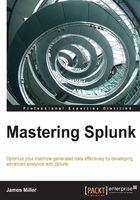
Search results
When you run a Splunk search, you'll see that not all of the Splunk Web search results tabs (Events, Statistics, and Visualization) will be populated.
- Event searches: If your search returns only events, only the Events results tab is populated
- Transformational searches: If your search includes transforming commands, you can view the results in the Statistics and Visualization tabs (as well as in the Events tab)
- Transformational commands: Transformational commands transform the event results into numerical values that Splunk can use for statistical purposes, that is, creating charts, tables, and graphs
Transforming commands include the following:
charttimechartstatstoprarecontingency
Some basic Splunk search examples
To illustrate the differences in the results tabs, let's use an earlier search example. You might recall the following search (using a macro that we created):
`TM1Events("october/24/2007")`
This search is a simple events search and will only populate the Events results tab. However, the Statistics and Visualization results tabs are not populated.
Now, we can add a transformation command (in this case, I've chosen to add the timechart command to break up our results from the search day as "events per second") to our search, as follows:
`TM1Events("october/24/2007")` | timechart per_second(date_second)
Now, all the result tabs are populated.
Additional formatting
Splunk also provides several commands to improve the look of your search results. These include the following:
abstract: This shows a summary of up to five lines for each search result.diff: This compares values between search results and shows the differences between the two.highlight: This highlights specified terms.iconify: This displays a different icon for each event type.outputtext: This outputs the_rawfield of your current search into_xml.scrub: This anonymizes the current search results.xmlunescape: This unescapes all XML characters.append: This is not a typical formatting command, but it is worth mentioning. This appends the current results to the tabular results of another search result.